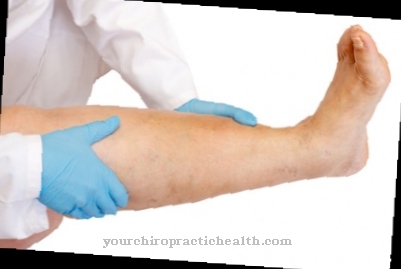Most people associate arising blue finger with cold. This does not have to be involved in the discoloration. Those affected should consult a doctor. Often the symptoms are not only unpleasant, they can also indicate illnesses.
What are blue fingers?

Blue areas of the body can be caused by cold. However, blue fingers are more likely to have a lack of oxygen or a bruise. There can be various reasons behind the insufficient oxygen supply, some of which require treatment. Blue fingers are rarely a symptom in their own right. Instead, they make the person concerned aware of a fundamental illness.
If the discoloration is accompanied by other symptoms, a connection to the cause can often already be established. The time at which the discoloration occurs is also decisive. Medical advice should be sought, especially if the changes were not caused by an accident caused by bruises or other physical influences.
causes
There can be different causes behind blue fingers. These include cyanosis, for example. This often causes discolored lips, but fingertips can also be affected by the changes. Ultimately, it is a question of a lack of oxygen. The blood is responsible for distributing the oxygen. The dye that turns blood red is called hemoglobin. If too little oxygen is put into the circulation, this can be noticed in the hemoglobin.
For oxygen enrichment, the blood is pumped through the heart into the lungs, where the gas exchange takes place. If this has been successfully completed, the blood is perceived as lighter. In the case of cyanosis, however, it appears bluish and the skin appears discolored. In addition, blue fingers can indicate Raynaud's syndrome.
The circulatory disorders result for different reasons. In general, it is a question of vascular constrictions that can occur in differentiated places. Raynaud's syndrome is often triggered by stress or cold, the disease occurs in the form of relapses. Furthermore, blue fingers can indicate bruises, heart valve defects and asthma.
Diseases with this symptom
- Bruises
- Dislocated finger
- bronchial asthma
- thrombosis
- Heart failure
- Hypoxia
- Broken finger
- Raynaud's Syndrome
- Sports injuries
- sprain
- cyanosis
- Polyglobules
- Flexor tendon injuries on the hand
- Compartment syndrome
- Polycythemia vera
- Heart attack
- Circulatory disorders
- Frostbite
Diagnosis & course of disease
First of all, the conversation is decisive for the diagnosis. The patient should have all important information ready. Often asked about the duration of the complaints and the exact circumstances. Pain and other symptoms should not go unmentioned. The external examination for possible swellings and injuries can already help to narrow down the broad spectrum of possible causes. If the doctor suspects the presence of Raynaud's syndrome, he can test the suspicion confrontationally.
The patient is exposed to a cold stimulus in order to observe the progress. Blood tests and ultrasound images can provide further information. If the doctor tests for cyanosis, he first examines the lips, ears, tip of the nose and mucous membranes. An existing discoloration already indicates a disturbance of the blood circulation.
The expression can provide information about the degree of the disease. If there are any further doubts, the fingers can be x-rayed and in this way conclusions can be drawn about the oxygen content. A laboratory test of the blood can be used to check how much oxygen is circulating in the patient's body.
Complications
Most of the time, blue fingers are just an indication that the hands are simply not warmed enough. But that does not necessarily have to be the cause of the discoloration, it can also be a serious illness. Those affected should therefore urgently see a doctor, only he can make a correct diagnosis. Cold is only one cause of blue fingers, but oxygen deficiency is also common.
External influences such as crushing can also cause blue fingers. If there is a lack of oxygen, it must be found out where the lack actually comes from. However, blue fingers are usually only a side effect; other symptoms also become noticeable.
The cause can often be identified from the other symptoms; blue fingers only draw attention to it. What is important is the point in time at which the blue fingers appeared, the doctor can draw conclusions from this. A medical diagnosis must be made, especially when there is no violence. If there is a lack of oxygen, the circuit must be enriched with oxygen. However, there may also be a circulatory disorder or blue fingers may indicate a heart valve defect. The doctor first tries to find access to the patient through a conversation and will ask about the duration of the blue fingers and of course about other symptoms. However, a blood count and ultrasound scan will help and the correct treatment can be initiated.
When should you go to the doctor?
There are several possible causes for blue fingers. In cold temperatures, blue fingers can develop without gloves. This process is less dramatic than blue fingers caused by a finger injury or cyanosis. In contrast to the first example, it can make sense to consult a doctor for the other two causes.
When a finger is crushed or bruised, blood leaks into the tissue and appears there as a bruise. It is often enough to simply wait until the injury has healed. In this case, the family doctor should only be contacted if the injury is major or complications arise. However, if there is a suspicion of insufficient oxygen supply with blue fingers, a doctor should be consulted immediately.
The family doctor is a good first point of contact. He already knows his patient, which is helpful for the diagnosis. The blue finger symptom can indicate heart disease, including heart valve defects, as well as poor circulation or asthma. Another possible trigger is Raynaud's syndrome, which can lead to cyanosis of the hands and fingers in addition to paleness or reddening. Each of the cases mentioned requires its own thorough treatment by an internist, cardiologist or pulmonologist.
Doctors & therapists in your area
Treatment & Therapy
Which treatment is used depends on the underlying cause. Accordingly, the diagnosis is relevant for the further course. If there are bruises and bruises, no further treatment is usually necessary. If there is pain and swelling, these can be alleviated with the help of various ointments. The doctor may prefer to use a bandage.
If there is bleeding under the fingernail, it must be pierced so that the fluid can drain off and the nail is retained. It is also advisable to take care of the affected finger. Raynaud's syndrome attacks can be treated preventively. The disease is not permanent and usually only shows up in certain situations. In addition to stress, these include cold above all else.
Those affected should take care not to come into contact with the cold. Gloves can help keep hands warm in winter and while cycling. In order not to further promote the development of vascular constrictions, the consumption of nicotine should be avoided. Patients find it helpful to limit stressful situations as much as possible. Relaxation techniques can have a supportive effect.
If the preventive measures were unsuccessful, warmth can be used in the event of an attack, for example in the form of a warm bath or a hot water bottle. In order for the vessels to enlarge, the affected area should be massaged. The attack usually subsides within 30 minutes. Otherwise a doctor should be consulted. In the case of cyanosis, treatment is based on what caused the lack of oxygen.
If there are only slight symptoms due to hypothermia, warmth is used. However, the acute form is often based on shortness of breath. Doctors give oxygen to the patient. Heart and lung diseases must be treated optimally. For valvular heart disease, patients usually require non-drug treatment. Ultimately, cynosis is only a symptom of an existing disease that needs treatment.
Outlook & forecast
Blue fingers are only a temporary symptom. In most people, the blue fingers only appear briefly and go away after a while. The lack of oxygen, which can result from cold or wet conditions, is responsible for the blue color. If a patient's fingers are blue, heat must be applied to the fingers and the entire body. The symptom will then go away within a few hours.
However, the blue fingers can also develop due to a disease in the arteries, which means that too little oxygen is transported to the fingers. With this malfunction, it is necessary to involve a doctor who will carry out the treatment. In most cases, a drug is used for this, which relieves the cramps and stimulates blood circulation again.
If you want to treat your blue fingers at home, you should definitely put them in warm water and massage them. This means that the blue color disappears relatively quickly. However, if the blue color lasts for several hours and does not disappear on its own, a doctor must be consulted urgently so that the fingertips do not die off. In most cases, however, this does not happen and home treatment is successful.
prevention
Blue fingers can only be prevented to a limited extent. During manual work, tools should be handled with care to avoid crushing. Frequent sporting activities help to stimulate the circulation of the blood in the body and to avoid circulatory disorders. Cyanosis is triggered by a number of different causes. Most can be prevented with a healthy diet and regular exercise.
You can do that yourself
Since the blue fingers are in most cases an undersupply of the fingers with oxygen, they have to be supplied with heat. A simple way to get rid of the blue fingers is therefore warmth. The fingers can be wrapped in a warm cloth or held in warm water. Hand warmers or warm clothing are also suitable for this. It is important that the water is not too hot if the fingers have become very cold beforehand. You may not be able to properly sense the heat, which will result in burns.
If the person concerned smokes, stop smoking. This allows the fingers to be supplied with enough oxygen again, which promotes blood circulation and removes the blue color from the fingers. In addition, a lot of exercise and sport help against blue fingers. Those affected should drink enough fluids. In most cases, the blue fingers go away on their own, but there are medications that relieve cramps. These contain nitrates and have a positive effect on the blood circulation in the fingers.
If there is a problem with the nerves and the fingers are blue for several hours, a doctor should be called. If the oxygen supply is too long, the fingertips can die.






.jpg)






.jpg)

.jpg)
.jpg)











.jpg)